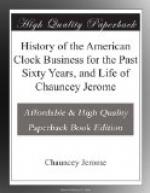I have explained the mode of setting up a clock with reference to putting it in beat, etc. Another essential point to be attended to is that the rod should hang in the centre or very near the centre of the loop in the crutch wire which is connected with the verge, and for this reason, if it rubs the front or back end of the loop, the friction will cause it to stop. To prevent this, set the clock case so that it will lean back a little or forward, as it requires. It sometimes happens that the dial (if it is made of zinc) gets bent in, and the loop of the crutch wire rubs as it passes back and forth. This should be attended to. It should be noticed also, whether the crutch wire gets misplaced so that it rubs any kind of a dial; the least impediment here will stop a clock. The centre of the dial should next be noticed. It sometimes happens that the warping moves it from its place, so that the sockets of the pointers rub, and many times it is the cause of the clock’s stopping; this can be remedied by pareing out the centre on the side required.
Soft verges are no uncommon cause of clocks stopping, and those who travel to repair clocks generally overlook this trouble. A clock with a soft verge will run but a short time, because the teeth will dent into the face of the verge and cause a roughness that will certainly stop it. The way to ascertain this, is to try a file on the end of the verge; if you can file it it is soft; they are intended to be so hard that a file will not cut them. They can be hardened without taking off the brass ears or crutch wires, if you are careful in heating them; but the roughness on the faces caused by the teeth must be taken out in finishing. They must be polished nicely, and the polish lines should run parallel with the verge: this may not seem to some necessary, but if the polished lines run crosswise you can hear it rub distinctly and it would cause it to stop.
It is very common to hear a clock make a creaking noise, and this leads inexperienced persons to think it has become dry inside. This is not so, and you will always find it to be caused by the loop of the crutch wire where it touches the rod; apply a little oil and it will cure it.




